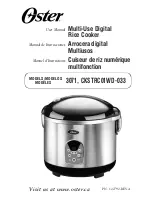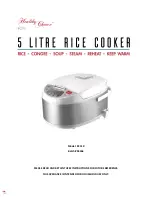
43
43
•
Inside of oven:
The oven should
always be cleaned after use when it
has cooled down. The cavity should be
cleaned using a mild detergent solution
and warm water. Suitable proprietary
chemical cleaners may be used only
on enamel after first consulting the
instructions supplied with the oven
cleaner and testing a small sample
on the oven cavity. Abrasive cleaning
agents or scouring pads/cloths should
not be used on the cavity surface.
NOTE:
The manufacturers of this
appliance will accept no responsibility
for damage caused by chemical or
abrasive cleaning.
Let the oven cool down and pay
special attention not to touch the
hot heating elements inside the
oven cavity.
CORRECT REPLACEMENT OF THE
AUXILIARY, SEMI-RAPID AND RAPID
BURNERS
It is very important to check that the burner
flame distributor “
F
” and the cap “
C
” have
been correctly positioned (see figs. 9.1,
9.2) - failure to do so can cause serious
problems with correct combustion and
may cause irreversible damage to the hob
surface.
CORRECT REPLACEMENT OF THE
TRIPLE RING BURNER
The triple ring burner must be correctly
positioned (see fig. 9.5); the burner rib
must be enter in their logement as shown
by the arrow (see fig. 9.3).
Then position the cap “
A
” and the ring “
B
”
(figs. 9.4, 9.5).
The burner correctly positioned must not
rotate (fig. 9.4).
Failure to do so can cause serious problems
with correct combustion and may cause
irreversible damage to the hob surface.
BURNERS AND PAN SUPPORTS
These parts must be cleaned using a
sponge and soapy water or other suitable
non-abrasive products. Dry with a soft
cloth.
Warning! Not dishwasher safe.
After cleaning, the burners and their flame
spreaders must be well dried and correctly
replaced.
It is very important to check that the
burner flame spreader and the cap have
been correctly positioned. Failure to do so
can cause serious problems with correct
combustion and may cause irreversible
damage to the hob surface.
Check that the electrode “
S
” (figs. 9.1,
9.3) next to each burner is always clean to
ensure trouble-free sparking.
Check that the probe “
T
” (figs. 9.1, 9.3) next
to each burner is always clean to ensure
correct operation of the safety valves.
Both the probe and ignition plug must
be very carefully cleaned.
Note: To avoid damage to the electric
ignition do not use it when the burners
are not in place.
Note: Continuous use may cause a
change in the glaze around the burners
and grids, corresponding to the areas
exposed to the heat. This is a natural
phenomenon and does not prevent the
parts from working properly.
ADVICE FOR USE AND MAINTENANCE
OF CATALYTIC PANELS (ONLY FOR
THE BOTTOM LEFT OVEN)
The catalytic panels are covered with
special microporous enamel which absorbs
and does away with oil and fat splashes
during normal baking over 200°C.
If, after cooking very fatty foods, the panels
remain dirty, operate the oven “idling” on
max temperature for about 30 minutes.
These panels do not require to be cleaned,
however it is advised to periodically
remove them from the oven (at least the
side panels) and to wash them with tepid
soapy water and then wipe off with a soft
cloth.
DO NOT CLEAN OR WASH THEM
WITH ABRASIVE PRODUCTS OR WITH
PRODUCTS CONTAINING ACIDS OR
ALKALIS.
The side panels are reversible and when
the catalytic microporous enamel degrades,
they can be turned to the other side.
Summary of Contents for Select 90DF3
Page 1: ...INSTALLATION INSTRUCTIONS AND USER GUIDE Select 90DF3 ISSUE D...
Page 9: ...9 9 Advice for the installer...
Page 23: ...23 23 Advice for the user...
Page 44: ...44 44 S F C T Fig 9 1 Fig 9 2 A B S T Fig 9 3 Fig 9 4 Fig 9 5...
Page 54: ...54 54...
Page 55: ...55 55...














































